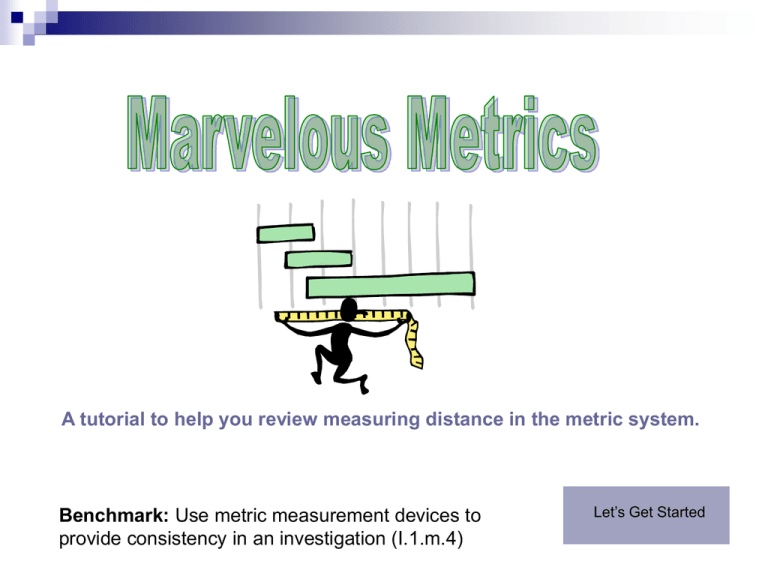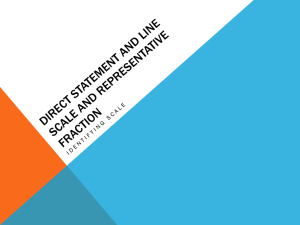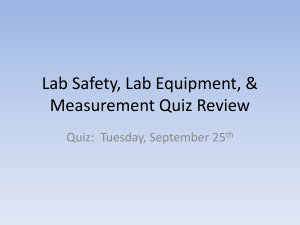Marvelous Metrics
advertisement

A tutorial to help you review measuring distance in the metric system. Benchmark: Use metric measurement devices to provide consistency in an investigation (I.1.m.4) Let’s Get Started Why do I have to learn metric if I live in the United States? Why not just measure everything in inches, feet, yards, and miles? Answer: Magnum est ut inter sese colloqui possint periti in scientiae rebus. Having trouble understanding the message above? It is a very simple phrase in Latin. Please Translate Translation: It is important that scientists can communicate with each other. Scientists around the world have to be able to communicate with each other. Just as you had difficulty reading the Latin phrase, imagine what would happen if every scientist used a different measuring system. That is why a universal system of measurement is necessary. This system is the metric system. Time to Measure All measurements during this tutorial will be made in centimeters. Look at the magnified ruler below. The distance from one tall line to another is one centimeter (cm). The smaller lines each represent one millimeter (mm). There are 10 millimeters in one centimeter. Prove this to yourself by counting the number of millimeters between 0 and 1 (do not count the 0 line, but you do count the 1 line). Since there are 10 millimeters in one centimeter, each millimeter line equals 0.1 centimeters. 0 1 2 3 4 .1 .2 .3 .4 .5 .6 .7 .8 .9 How many centimeters are shown on the ruler segment above? Four Forty 0 1 2 3 4 There are 4 cm shown on the ruler above and 40 mm. I’m ready to move on. There are 40 mm below. The millimeter markings are the shorter lines. But there are only 4 centimeters. The centimeters are circled. 0 1 2 3 4 Practice Again How many centimeters are shown on the ruler segment below? Eleven One 0 1 0 1 There is 1 cm shown on the ruler above and 11 mm. I’m ready to move on. There is 1 cm shown on the ruler above and 11 mm. Remember the smaller lines are the millimeters. 0 1 Let’s go back and review We can compare measuring in metric with money. It takes 10 millimeters to equal 1 centimeter. Just like it takes 10 dimes to equal 1 dollar. On the paperclip below, if you could give yourself 1 dollar for each full centimeter that the paperclip covers, you would have $3. But wait, the paperclip goes past the 3 cm mark, so shouldn’t you get more money? Yes, give yourself 1 dime for each millimeter beyond the 3 cm. How much money do you have? $3 + $0.30 = ? You should have $3.30 Follow a similar method when measuring in metric. How many full centimeters long is the paper clip? 3 cm Now count the number of millimeters beyond the 3 cm mark. 3 Remember a millimeter equals 0.1 cm. Putting it all together, 3 cm + 0.3 cm = ? The paperclip is 3.3 cm long. Notice how this answer compares to your dollar answer at the top of this slide. How long is the domino? A. 5.1 cm C. 51 cm The domino is 5.1 cm long. How long is the car? A. 71 cm B. 7 cm C. 7.1 cm The car is 7.1 cm. You’re ready to move on. Next How tall is the Coke can? A. 122 cm B. 12.2 cm C. 12 cm The Coke can is 12.2 cm tall. One More Practice How long is the straw? A. 195 cm B. 19.1 cm C. 19.5 cm The straw is 19.5 cm long. You’re really good at measuring. One Last Practice Try using the money analogy if that helps you. Give yourself $1 for each centimeter mark that the domino covers. You would have $5. It looks like the domino is a little past the 5 cm mark. Give yourself 1 dime for that millimeter. How much money do you have? $5.10 Now do the same thing, but ask yourself about centimeters and millimeters. How many full centimeters long the domino is. 5 Count the number of millimeters beyond the 5. How long is the domino? Try Again The car is not 71 cm long. Decide how many full centimeters long the car is. Write this number in front of the decimal. 7.____cm Now count the millimeters after the 7. Remember, a millimeter is equal to 0.1 cm. So the number of millimeters you count goes behind the decimal point. .1cm Your final answer is 7.1 cm. Another Practice Please Remember to count the number of millimeter markings after the 7 cm line. Try Again How wide is the disk? A. 9.4 cm B. 9.5 cm C. 9 cm The disk is 9.4 cm. Next Be careful. The slightly longer line between 9 cm and 10 cm represents 5 millimeters or 0.5 cm. If the disk is one millimeter before 0.5 cm, how long must the disk be? You can also re-count all of the millimeter markings after the 9 until you get to the end of the disk. Try Again It appears that the disk extends beyond the 9. Use the black horizontal line, that indicates the end of the disk, as a reference. Try Again The Coke can is 122 millimeters tall, not 122 cm. But remember we are making all measurements in centimeters. How many full centimeters tall is the can? That number goes in front of the decimal. 12.__cm How many millimeters beyond the 12 cm mark does the can extend? .2cm Put it all together, and try again. Try Again Look again. Are you sure it is exactly 12.0 cm, or does the can extend a few millimeters after the 12 cm mark? Try Again Remember your answer should have the general form of ____ ____ . ____ cm. The numbers to the left of the decimal represent centimeters (just as it would represent dollars if we were talking about money) and the number to the right of the decimal represents the smaller millimeters (just like dimes in money). Try Again Notice the slightly larger millimeter line between the 19 cm and 20 cm. This line represents 0.5 cm. If you count the millimeters after 19, you will count 5 when you reach that line. 0.5 cm marks are slightly longer to make reading the ruler a little easier. Try Again A meter stick is used to measure a floor tile. In centimeters, how long is the tile (include the grout line between tiles)? A. 96.5 cm B. 96.1 cm C. 96.0 cm Challenge Me You chose 96.1 cm which is the measurement shown by the purple arrow. The tile with grout extends to the yellow line. Try Again Are you sure the tile and grout ends at exactly 96 cm? The purple line represents the distance you are measuring. Try Again What measurement is indicated by arrow on the ruler segment below? A. 4.0 cm B. 0.4 cm 0 1 C. 4.4 cm You knew exactly what to do. The arrow does represent 0.4 cm. 0 1 I’m Ready for the Test Follow the same pattern as we’ve done in all of the previous measurements. How many full centimeters to get to the arrow? In this case the answer is 0 cm. The arrow is not to the 1 cm mark. So we write 0.___cm Now count the number of millimeter marks to the arrow. You should count 4. So we write 0.4 cm. If you were receiving money for this measurement, how much would you have? A dime for a millimeter. $0.40 0 1 .1 .2 .3 .4 Another Practice Please You chose 4.4 cm. The orange arrow on the ruler segment below is pointing to 4.4 cm. 0 1 2 3 4 Below is the line segment you were given. What number should be to the left of the decimal? 0 1 Try Again What measurement is indicated by arrow on the ruler segment below? A. 7.0 cm B. 0.2 cm 0 C. 0.7 cm 1 The arrow does point to 0.7 cm. 0 1 I’m Ready for the Test Look carefully, is 7 cm shown on the ruler segment? No the ruler is only showing up to 1 cm, and the arrow is not to the 1. So we must write a 0.__cm If you count the millimeter lines, there are 7 to get to the arrow. Is that why you chose 7cm? But those lines represent 0.1 cm each. So, what would the correct answer be? 0 1 .1 .2 .3 .4 .5 .6 .7 .8 .9 Try Again Remember the slightly taller line between the 0 cm and 1 cm represents 0.5 cm, and is taller to help read the ruler. If the purple arrow is two lines after the 0.5 cm line, what measurement must it be indicating? 0 1 .5 Try Again Time to Show What You Know 1. How long is the keyboard? A. 45 cm B. 45.5 cm C. 50cm Next Question Oops Not the right measurement. Try Again 2. What measurement is indicated by the purple arrow? A. 3.6 cm B. 36 cm 0 1 2 C. 3.1 cm 3 4 Next Question Oops Not the right measurement. Try Again 3. How wide is the outdoor chair? A. 89 cm B. 82. 8 cm C. 82.3 cm Next Question Oops Not the right measurement. Try Again 4. What measurement is indicated by the purple arrow? A. 2 cm B. 0.7 cm 0 1 2 C. 0.2 cm 3 4 Next Question Oops Not the right measurement. Try Again 4. What measurement is indicated by the purple arrow? A. 0.9 cm B. 9 cm 0 1 C. 1.1 cm 2 3 4 Oops Not the right measurement. Try Again You Have Finished This Tutorial Being able to accurately measure is an important science skill. This skill will be necessary for later concepts such as finding the area in order to calculate pressure, finding volume in order to calculate density, and measuring distance to calculate speed. Resources All clipart and sounds during slide transitions from: Microsoft Office Online. 19 Apr. 2007 <http://office.microsoft.com/enus/clipart/FX101321031033.aspx?pid=CL100570201033>.






